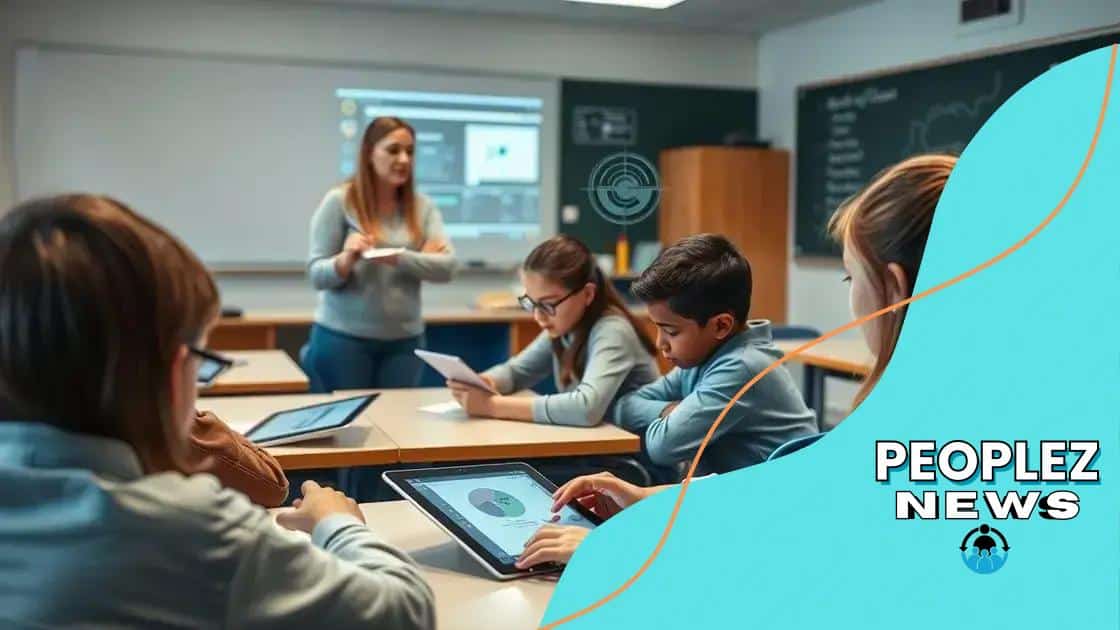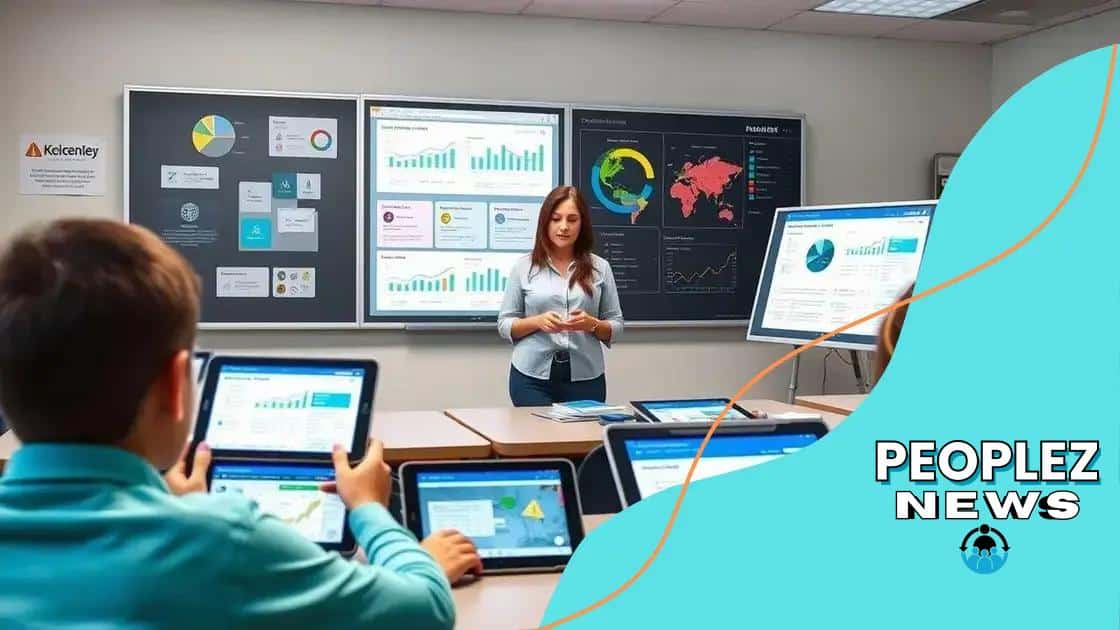AI in tracking student progress and engagement

AI in tracking student progress and engagement personalizes learning, provides real-time feedback, and utilizes advanced tools to enhance educational experiences and outcomes for students.
AI in tracking student progress and engagement offers innovative solutions for educators seeking to enhance learning experiences. Have you considered how technology can help teachers better understand their students’ needs? Let’s delve into how AI is reshaping education.
Understanding AI in education
Understanding AI in education is essential as technology increasingly shapes the learning experience. With the rapid growth of artificial intelligence, schools are leveraging its capabilities to better understand student needs and enhance engagement.
The Role of AI in Learning
AI tools analyze data and provide insights that help teachers tailor their instruction. These tools can track patterns in student performance, enabling educators to identify areas where students may need additional support.
Benefits of AI in Education
Some key benefits of using AI in education include:
- Personalized learning experiences for each student.
- Real-time feedback for teachers and students.
- Efficient data management to streamline administrative tasks.
- Enhanced engagement through interactive learning tools.
Moreover, AI can help reduce biases in grading. By utilizing objective algorithms, teachers can ensure fairness in assessing student work. This promotes a more equitable environment, allowing every student to thrive based on merit.
As AI technologies evolve, they can also facilitate automated administrative tasks. This allows educators to focus more on teaching rather than paperwork. For instance, scheduling and resource allocation can be managed efficiently, ultimately benefitting the students.
The integration of AI applications means classrooms can become more vibrant and responsive to student needs. With effective implementation, teachers can unlock new potentials for student success.
Through understanding AI in education, educators can pave the way for more innovative and adaptive learning environments.
Key benefits of tracking student engagement
Tracking student engagement offers many advantages that can transform the educational landscape. By understanding how students interact with material, teachers can adapt their methods to improve learning outcomes.
Enhanced Learning Experience
One key benefit is the ability to create a more personalized learning experience. When engagement is monitored, educators can identify which areas students find interesting or challenging.
Real-Time Feedback
Providing real-time feedback is crucial in maintaining motivation. With tools that track engagement, teachers can quickly address concerns and reinforce positive behavior.
- Immediate intervention can prevent students from falling behind.
- Students receive constructive feedback, making their learning more effective.
- Building a responsive teaching environment enhances student-teacher interactions.
- Encouraging a growth mindset fosters resilience in students.
Moreover, tracking engagement helps in assessing the effectiveness of different teaching strategies. Educators can test new approaches and analyze engagement levels to determine what works best. This data-driven decision-making leads to a more dynamic and effective classroom.
Engaging students actively promotes participation, leading to improved retention of information. When students feel involved, they are more likely to show enthusiasm for learning new concepts.
Incorporating strategies to measure student engagement ensures that every learner’s voice is heard, and their needs are met. By prioritizing these insights, educators foster a supportive environment where students can flourish.
Tools for monitoring student progress

Tools for monitoring student progress have revolutionized the way educators track learning outcomes. With advancements in technology, teachers now have access to various platforms that provide insights into student performance.
Types of Monitoring Tools
There are several types of tools available that cater to different aspects of student progress. These tools can be web-based applications or mobile apps, making them easily accessible.
Key Benefits of Monitoring Tools
Utilizing these tools offers multiple advantages:
- Identifying learning gaps quickly.
- Creating customized learning plans tailored to student needs.
- Tracking progress over time to visualize growth.
- Fostering communication between teachers and parents.
Some popular monitoring tools include learning management systems (LMS) such as Google Classroom and Schoology. These platforms allow teachers to post assignments, grades, and feedback in real-time, enhancing transparency and engagement.
Additionally, assessment tools like Quizizz and Kahoot! provide immediate insights into student understanding after assessments. By analyzing results, educators can adjust their teaching methods accordingly.
Another vital aspect is the use of analytics dashboards. These dashboards consolidate data from various sources, presenting it in a user-friendly format. Teachers can easily interpret the data, enabling them to make informed decisions about their instruction.
Incorporating technology to monitor student progress is a game-changer. It not only benefits the educators but also engages students by allowing them to take ownership of their learning.
Real-world examples of AI in classrooms
Real-world examples of AI in classrooms show how technology can enhance learning experiences. Schools around the world are adopting AI solutions to address diverse educational needs.
Adaptive Learning Platforms
Many classrooms use adaptive learning platforms like DreamBox Learning and IXL. These platforms adjust the difficulty of tasks based on each student’s performance, providing personalized learning paths that cater to individual strengths and weaknesses.
AI-Powered Tutoring Systems
AI-powered tutoring systems, such as Carnegie Learning, offer students one-on-one support. These systems analyze student data to deliver targeted assistance, which helps them grasp complex concepts more effectively.
- Students receive instant feedback on their work.
- The system identifies areas needing improvement.
- Supports differentiation in instruction.
- Increases student confidence as they master skills.
Another compelling example is the use of chatbots in educational settings. Chatbots, like those implemented in various learning management systems, provide students with instant answers to common questions. This immediate support can enhance student engagement and reduce frustration.
Further, schools are using AI-driven analytics tools to track student progress. These tools help teachers analyze trends and make data-driven decisions to improve instructional strategies. By visualizing data, educators can see which methods are effective and which need adjustment.
AI in classrooms not only assists teachers but also empowers students. By providing personalized resources and feedback, students are more motivated to learn and succeed.
Future trends in educational technology
Future trends in educational technology are exciting and transformative. As technology continues to evolve, it shapes how students learn and how teachers deliver instruction.
Increased Use of Artificial Intelligence
One major trend is the increased use of artificial intelligence. AI will play a crucial role in personalizing learning experiences. Systems will adapt to students’ learning speeds and preferences, ensuring they receive the help they need when they need it.
Virtual and Augmented Reality
Virtual and augmented reality (VR and AR) are set to revolutionize classroom experiences. These technologies will allow students to engage in immersive learning environments. For example, students can take virtual field trips to historical sites or explore the human body in 3D. This hands-on approach helps maintain interest and improves retention of information.
- Enhanced engagement through interactive scenarios.
- Opportunities for experiential learning.
- Promotion of creative thinking and problem-solving skills.
Another trend is the shift towards blended learning models. By combining traditional classroom methods with online resources, teachers can create flexible learning environments. This approach meets diverse learning needs and allows students to take more control over their education.
Moreover, data analytics will become more prevalent in education. Teachers will utilize data to track student progress closely and refine their teaching strategies. This data-driven approach enables educators to identify trends and tailor their lessons for maximum effectiveness.
Ultimately, the future of educational technology holds great promise. With continuous advancements, learning will become more accessible, engaging, and effective for students everywhere.
In conclusion, the use of AI in tracking student progress and engagement is changing the educational landscape. By understanding how students learn and interact with material, teachers can offer personalized support that meets individual needs. With tools that monitor engagement and progress, educators can adapt their methods for more effective learning. The future of educational technology promises even more exciting developments, making learning more interactive and student-centered. By embracing these changes, schools can foster environments where all students can thrive.
FAQ – Frequently Asked Questions about AI in Tracking Student Progress
How does AI personalize learning for students?
AI analyzes student performance and adjusts learning paths to meet individual strengths and weaknesses, ensuring personalized education.
What tools are commonly used to track student engagement?
Tools like Google Classroom, DreamBox Learning, and Carnegie Learning help teachers monitor engagement and provide real-time feedback.
Why is real-time feedback important in education?
Real-time feedback helps address students’ challenges immediately, keeping them engaged and motivated to learn.
What are the future trends in educational technology?
Future trends include increased use of AI, virtual and augmented reality for immersive learning, and the rise of data-driven decision-making in classrooms.





